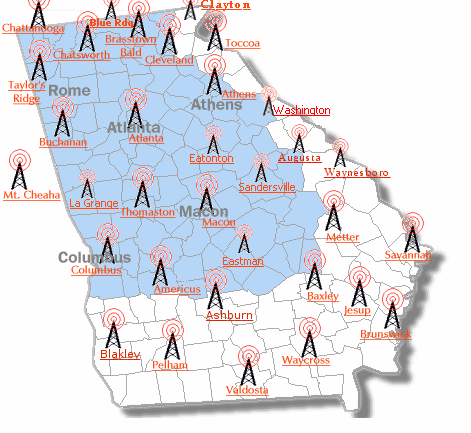The National Weather Service in Peachtree City provides programming for 17 NOAA Weather Radio (NWR) transmitters across north and central Georgia. Over 2 dozen transmitters cover Georgia from the mountains to the coast offering weather watches, warnings, forecasts, hourly conditions, and other information. Broadcasts are offered 24 hours a day, 7 days a week, every single day of the year. NOAA Weather Radio is a crucial source of weather and public safety information and should be one of many ways you stay informed about the weather.
| 3 Easy Steps to Get Started! |
| 1. Buy a NOAA Weather Radio receiver |
| 2. Tune into your local NWR broadcast |
| 3. Program your radio with your SAME FIPS code |
1. Buy a NOAA Weather Radio receiver
In order to tune in to NOAA Weather Radio, you must own a compatible receiver. NOAA Weather Radio receivers are available in stores ranging in price from $20 to $80. Other radio receivers may also feature the weather band which covers the 7 frequencies (162.400 MHz to 162.550 MHz) used to broadcast NOAA Weather Radio. Newer receivers on the market also feature the ability to display on-screen information in English, Spanish, and French.
 We cannot recommend one brand of receiver over another, but we do suggest that you look for receivers which carry the Public Alert logo. Devices which carry the Public Alert logo meet certain technical standards and come with important features including SAME technology, battery backup, and tone alarm. For more information on NOAA Weather Radio receivers, please visit the national NOAA Weather Radio receivers page.
We cannot recommend one brand of receiver over another, but we do suggest that you look for receivers which carry the Public Alert logo. Devices which carry the Public Alert logo meet certain technical standards and come with important features including SAME technology, battery backup, and tone alarm. For more information on NOAA Weather Radio receivers, please visit the national NOAA Weather Radio receivers page.
 2. Tune into your local NOAA Weather Radio broadcast
2. Tune into your local NOAA Weather Radio broadcast
The vast majority of Georgia enjoys NOAA Weather Radio coverage from at least one transmitter. However, it may be necessary to use an external antenna to receive NWR broadcasts if you are distant from the tower. Generally, NOAA Weather Radio broadcasts are receivable at a 40-mile range from the tower depending on transmitter power, topography, broadcast antenna height, and atmospheric conditions. An interactive NOAA Weather Radio network map, and a low bandwidth version, are available online to help locate NOAA Weather Radio transmitters that cover your county, their frequency, the county code to program into your radio, and a signal coverage map.
3. Program your radio with your SAME FIPS code
Specific Area Message Encoding (SAME) allows NOAA Weather Radio receivers with SAME capability to be programmed to listen and alarm for messages affecting a specific county or set of counties. Programming a NOAA Weather Radio SAME receiver with a county's Federal Information Processing Standards (FIPS) code, easily available online or by calling 1-888-NWR-SAME (1-888-697-7263), will cause the receiver to only alarm for your intended area. Some radios may not feature SAME technology and will alarm for any county covered by your transmitter. Please ensure your NOAA Weather Radio receiver is tuned to a broadcast offering service to your area of interest as no transmitter sends out messages for all Georgia counties!
Routine weekly tests of NOAA Weather Radio are conducted on Wednesday mornings between 10 AM and noon, weather permitting. If a test must be postponed due to weather, it shall be conducted on the next good weather day between 10 AM and noon.
Quick Links